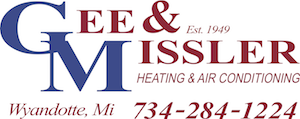
A furnace is usually a background player at home, ensuring you're warm in the cold winter months. It regularly won't be noticed until something goes wrong.
One cause might be that your furnace has a cracked heat exchanger. It can potentially be hazardous, so it’s worthwhile to familiarize yourself with the signs of a cracked heat exchanger and what you should do if you are worried that may be the problem.
What Is a Heat Exchanger in a Furnace?
A heat exchanger helps move heat from the combustion chamber inside your furnace to the air that circulates throughout the air ducts. It usually handles this via coils or tubes that warm the air while serving as a barrier to keep gas produced in the combustion chamber, called flue gasses, from leaking out into your home.
Is a Cracked Heat Exchanger Dangerous?
Because of its key role, it shouldn't come as a surprise that a broken heat exchanger can pose a risk. A crack in the heat exchanger can enable dangerous gasses – such as carbon monoxide, which can be lethal – to be distributed across your home.
For this reason, do NOT turn on your heating if you suspect there's a crack in the heat exchanger, as doing so could make the whole household ill. Call an HVAC professional right away if you are worried your furnace has a cracked heat exchanger that should be repaired.
Four Signs of a Cracked Heat Exchanger:
- Furnace shuts off: A crack in your heat exchanger could cause your furnace to switch off.
- Unusual Smells: If the air escaping your furnace has a strong chemical scent, it could be evidence gas is seeping through cracks in your heat exchanger. These byproducts, which can smell like formaldehyde, are a significant warning sign.
- Carbon monoxide alarm is triggered or you recognize symptoms of poisoning: If a cracked heat exchanger is emitting carbon monoxide inside your home, your carbon monoxide alarm could go off or family members might struggle with signs of carbon monoxide poisoning. Complications include headaches, dizziness, weakness, nausea, vomiting or feeling drowsy. If an alarm goes off or you feel unwell, get out of the home right away and then call for help.
- Soot: If you find black sooty accumulating around the exterior of your furnace, it’s an indication something could be seriously wrong.
What to Do if a Furnace Heat Exchanger is Cracked
If you worry your furnace has a cracked heat exchanger, contact a professional experienced in furnace installation Wyandotte as soon as possible so they can examine your system and, if needed, perform a furnace heat exchanger replacement. Costs will vary depending on the situation, but estimates often hover around $1,000 to $3,000.
However, the good news is that heat exchangers are generally included in the warranty. You’ll want to review the warranty paperwork on your furnace, because while the warranty might not cover the entire cost of repairs, it could significantly lower your bill.
How to Avoid a Cracked Heat Exchanger in Your Home
One of the best ways to prevent a problem in your furnace overall is through regular furnace maintenance. Furnaces provide the best possible return on investment when they operate efficiently. Calling a skilled professional to examine your furnace for old parts, clogs in the air filters and other likely problems can help you avoid getting a big bill later on.
It’s also a good idea to inspect your furnace filters every few months – it’s recommended some filters be replaced every 90 days or sooner if they are dirty or grimy. While the filters are not part of the heat exchanger itself, the strain of drawing air through a clogged filter makes your entire furnace work longer to accomplish its job. And the harder your furnace has to work, the more wear and tear parts like the heat exchanger will endure.


